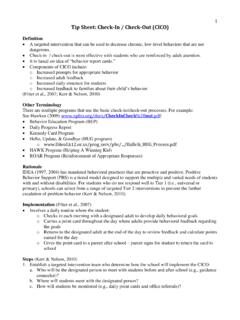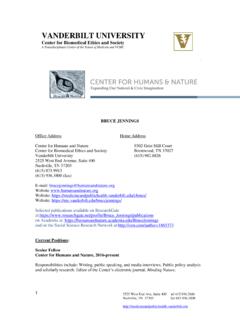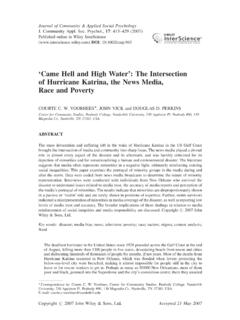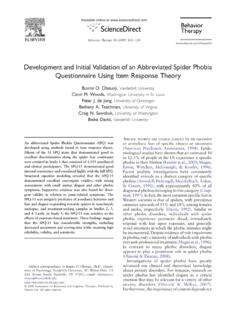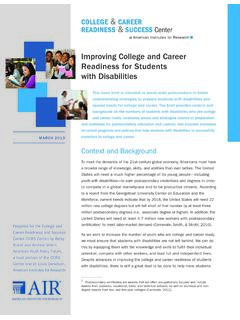Transcription of Preparing Students With Disabilities for School-to Work ...
1 Work is a central part of adultlife, consuming as much ashalf of our waking hours. Peo-ple often identify themselves by thework that they do. A job can provide asense of accomplishment and pride andhave an enormous effect on our overalllife satisfaction, or it can serve as asource of frustration and the right job simply knowingwhat it might be is not easy, even forhighly skilled individuals. Doing so iseven more difficult for those who lackadequate training or face specialchallenges, such as a disability. Accord-ing to nationwide studies, as many as66% of working adults never had a ca-reer plan and are currently working attheir jobs because of chance factors orthe influence of others or because itwas the only job available. Only abouthalf of these workers are satisfied withtheir job situation (Brown & Minor,1989; Hoyt & Lester, 1995). Preparing Students for the workforceis an important role for schools or atleast it should be.
2 However, most schools emphasize college prepara-tion, which often overshadows attentionto actual workforce readiness. Althougha college degree is an excellent advantagein finding a rewarding job for a greatnumber of people, postsecondary educa-tion is not the optimal or even possiblechoice for many Students . Unfortunately,about half of Students leave highschool without the knowledge or skillsneeded to find and maintain a job ( of Labor, 1991), and one-third of Students are not prepared foreven entry-level work ( GeneralAccounting Office, 1993). Transition Services forStudents with DisabilitiesCompared to their nondisabled peers, Students with Disabilities are more likelyto experience unemployment or under-employment, lower pay, and job dissat-isfaction (Dunn, 1996). Many studentswith Disabilities as well as those withchronic achievement problems dropout of high school before graduating,leaving them even more unprepared forand less likely to obtain a job.
3 Highschools can better engage and supportthese Students by helping identify theirstrengths and interests and providingthem with the skills (or a plan for gain-ing them) they need to succeed in to the Twenty-FirstAnnual Report to Congress on theImplementation of the Individuals withPreparing Students with Disabilities for School-to -WorkTransition andPostschool LifeSTOCK PHOTO IMAGEBy Edward M. Levinson and Eric J. PalmerEdward M. Levinsonis a professor of educational and school psychology at IndianaUniversity of Pennsylvania and has been a school psychologist for more than 25 J. Palmeris a graduate student in the school psychology program at IndianaUniversity of Pennsylvania and previously worked as a vocational specialist withGoodwill Industries of Pittsburgh, PA. Counseling 101 is provided by the NationalAssociation of School Psychologists ( ).P L A P R I L 2 0 0 511C O U N S E L I N G 1 0 1 Preparing Students with Disabilities for the workforce requires a comprehensive transdisciplinary vocational assessment and an emphasis on postschool planning.
4 Disabilities Education Act ( of Education, 1999), onlyabout one-fourth of Students with dis-abilities graduate from high school witha diploma; however, these Students wereless likely to drop out of school andmore likely to be competitivelyemployed if they received adequate voca-tional education training in high , there are key legal entitle-ments the Carl D. Perkins VocationalAct and the Individuals with DisabilitiesEducation Act (IDEA) that mandateworkforce preparation for Students withdisabilities. School administrators shouldbe familiar with these provisions forvocational assessment and training andensure that school programs are consis-tent with these course, many Students with dis-abilities do go to college and have greatsuccess, and school personnel shouldnever downgrade their expectations forthese Students . It is important for prin-cipals to build the capacity of their staffmembers to help Students and theirparents accurately determine whatvocational and life skills training isappropriate.
5 The core elements of work-force preparation for Students with dis-abilities are the same as those for theirnondisabled peers awareness of inter-ests and aptitudes, exposure to careeroptions, and assessing and buildingskills but they require more extensiveand individualized support from schoolpersonnel and other adults. Assessment and Planning:Keys to SuccessfulPostschool TransitionsTransdisciplinary AssessmentA major ingredient of a successfulschool-to-work transition program is acomprehensive, transdisciplinary voca-tional assessment that integrates a varietyof school and community agency per-sonnel into the assessment process. Theassessment process should include teach-ers, counselors, and psychologists aswell as representatives from communitymental health/mental retardation, voca-tional rehabilitation, and social servicesagencies who work together to identifyrelevant transition needs and plan appro-priate services.
6 Parents, state agencies,employers, business organizations, andstudents must also be involved in thevocational assessment to some goal of the vocational assess-ment is to facilitate educational andvocational planning that will allow astudent to make a successful adjustmentto work, postsecondary education, andcommunity living. Without a compre-hensive assessment of a student s skills,it is difficult to identify the needs thatshould be addressed in the student stransition plan. Components of a ComprehensiveVocational AssessmentAssessment data can be gatheredthrough published tests and surveys aswell as from directly interviewing andobserving a student. The assessmentshould address the following areas: Academic skills Daily living skills Personal and social skills Occupational and vocational skills(including performance tests that assessa student s ability to perform specificjoblike tasks; work samples that exposea student to natural job responsibilities;and situational assessments that meas-ure a student s interests, abilities, andwork habits in actual and contrivedwork environments) Career maturity (the extent to whicha student possesses adequate under-standing of themselves, adequate under-standing of the work world, and ade-quate decision-making skills) Vocational interests (assessment toolsinclude Self-Directed Search [SDS], theStrong Interest Inventory; the CareerKey.)
7 And the Occupational AptitudeSurvey and Interest Assessment, secondedition [OASIS II]) Vocational aptitudes (assessment toolsinclude the Differential Aptitude Test[DAT], the Armed Services VocationalAptitude Battery [ASVAB], and theOccupational Aptitude Survey andInterest Assessment, second edition[OASIS II]).Strengths (advantages) and weak-nesses (disadvantages) in each areaC O U N S E L I N G 1 0 112P L A P R I L 2 0 0 5 MANDATED VOCATIONAL SERVICES FOR STUDENTSWITH DISABILITIESTwo key legislative acts that address workforce preparation of Students are theCarl D. Perkins Vocational Education Act and the Individuals with Disabilities Edu-cation Act (IDEA). The purpose of the Perkins Act, which is currently in theprocess of being reauthorized, is to provide technical training and education tostudents who do not necessarily plan on going to college. The act requiresschools to provide parents and Students with : Vocational education opportunities, which should be offered to the student bythe beginning of ninth grade or one year before the student enters the grade inwhich vocational education is offered Eligibility requirements for enrolling in vocational addition, Students with Disabilities are entitled to receive: An assessment of interests, abilities, and special needs as well as other specialservices designed to help Students enrolled in vocational education transitioninto postschool employment or training.
8 Career assessment, planning, training, and School-to -work transition requires schools to provide services to Students with Disabilities that will helpthem make a successful transition from school to postschool activities such aswork, continued training or education, and other aspects of community living. By age 14, a student should have a transition plan incorporated into their IEPthat specifies what services the student needs to make a successful transitionfrom high school to work and community living, what career activities the stu-dent should undertake, and who will be providing the required services. should be identified and inferencesshould made about how these factorswill affect the student s ability to make asuccessful transition from school towork and community living. The infor-mation should then be used to helpestablish realistic occupational and inde-pendent living goals for the student. Roles of Professionals inAssessment and PlanningTeam members roles in the assessmentand transition planning process willvary according to their interests, expert-ise, and the amount of time each has todevote to the process.
9 Principals canassume a leadership role by encouragingand establishing links with communityagencies, promoting a transdisciplinaryapproach to the assessment and plan-ning process, assisting in the develop-ment of specific policies and proceduresrelevant to the process, and ensuringthat adequate resources are devoted toassessment and planning. Althoughprincipals may oversee the assessmentand planning process in their schools,special education coordinators and tran-sition coordinators may share some ofthe responsibility for case managementand oversight of the process for individ-ual Students . School psychologistsshould be involved in conducting psy-choeducational assessments, explainingassessment results, and making recom-mendations to the team. In particular,school psychologists can assist in gather-ing information relevant to a student scognitive, academic, and interpersonalskills. Counselors can also assist in datacollection by administering vocationalinterest and aptitude measures, provid-ing career guidance, coordinating careerdays or career fairs, and matching thestudent with appropriate from state agencies, such asrepresentatives from the state offices ofvocational rehabilitation, mentalhealth/mental retardation, and socialservices, should also be involved in theprocess.
10 Such agencies provide casemanagement services and funding forservices that Students will need whenthey leave high school. Representativesfrom these agencies can help arrangecommunity living, job training, educa-tion, transportation, and example, many vocational rehabili-tation agencies are involved in trainingstudents for employment, helping stu-dents obtain and maintain employ-ment, and transitioning them into worksettings. Further, these representativescan help Students and their families filethe necessary paperwork and applica-tion materials to ensure that all neces-sary services are available to the studentswhen they leave school. Finally, the student should beactively involved in the transition plan-ning process and attend all meetings. Itis the student s future that is at stake,and he or she should begin to takeIMPORTANT VOCATIONAL SKILLS TO LEARNV ocational training should provide Students with a curriculum that prepares themfor the job that they intend to enter.
